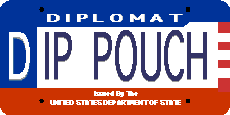



Some of you may have missed it entirely. One day, it appeared, and within 48 hours it was gone. It was all my fault, my doing, blame me. I thought it was clever. I was not alone in having that opinion, but for certain I was part of a rather small minority. For those who missed it, or who saw it but didn't get it, allow me to explain.
First of all, the new logo was never meant to take the place of the old one. We were testing out the new one, with the idea that if it was well-received by readers (perish the thought!) we would set up the main section pages to present either the original logo or the new one at random.
My main mistake was in taking for granted that people would realize the significance of the new logo. From the written reactions we received, it was clear that this was not the case. Some people thought it was just a stylized modernistic blocky logo. It wasn't.
Other people were offended by the U.S.-centric aspect of the logo. Obviously the red, white and blue color scheme, and the text mentioning the U.S. Department of State seemed out of place if the meaning of the logo wasn't clear. One response we received suggested caustically that perhaps a Swedish flag with "DipPouch" all over it would be a suitable logo.
At least one person who responded recognized the logo as being supposed to look like a license plate. That it was -- but it was not a complete fabrication made to look somewhat like a license plate. It was, in fact, modeled after a specific kind of license plate: the diplomatic plates issued in the U.S. So while I'll grant that the logo is U.S.-centric, that choice of logo was for the symbol it represented for Diplomats, not for anything it symbolized for the U.S as a country.
And actually, a fair amount of effort went into rendering a realistic likeness of the U.S. diplomatic plates. I hunted down a jpeg of a real diplomatic plate and traced over it to get the right shapes, lines, and angles, in the right places. The colors don't match the real ones perfectly, but they're pretty close, down to the fact that the shade of blue for the letters is darker than the shade of blue for the top and left sides of the plate. The lettering is "shadowed" to give the impression of raised letters, as on a real U.S. license plate. The size and style of the lettering is also pretty close to what it should be. And the subtlest point, if you haven't seen many of these plates, is the fact that all diplomatic plates are designated as such by starting with a blue "D" at the left, and then have the actual license number after that. So using that D as the first letter of DIPPOUCH worked out rather nicely. The more basic inaccuracies are that real diplomatic plates have fewer than the seven characters needed for "IPPOUCH", and also that the plate is always composed of a mix of letters and numbers, and never just letters.
Perhaps the logo would have been more successful if more people had recognized its significance, and perhaps it was naïve of me to not think that many readers in the U.S. and even more readers outside the U.S. would not have had the opportunity to see diplomatic plates, and thus wouldn't recognize them. The thought did occur to me, actually. I knew that not everyone would get it, but I thought that the concept of diplomatic plates was generally known, and that most people who didn't specifically recognize it would infer its meaning from the fact that it looked like a license plate and said DIPLOMAT across the top. Okay, so you still like the original logo better, but perhaps with this explanation you can begrudgingly admit "Well... maybe it is just a little clever." Or perhaps not. But at least you get it now if you didn't before.

|
Simon Szykman ([email protected]) |
If you wish to e-mail feedback on this article to the author, and clicking on the envelope above does not work for you, feel free to use the "Dear DP..." mail interface.

